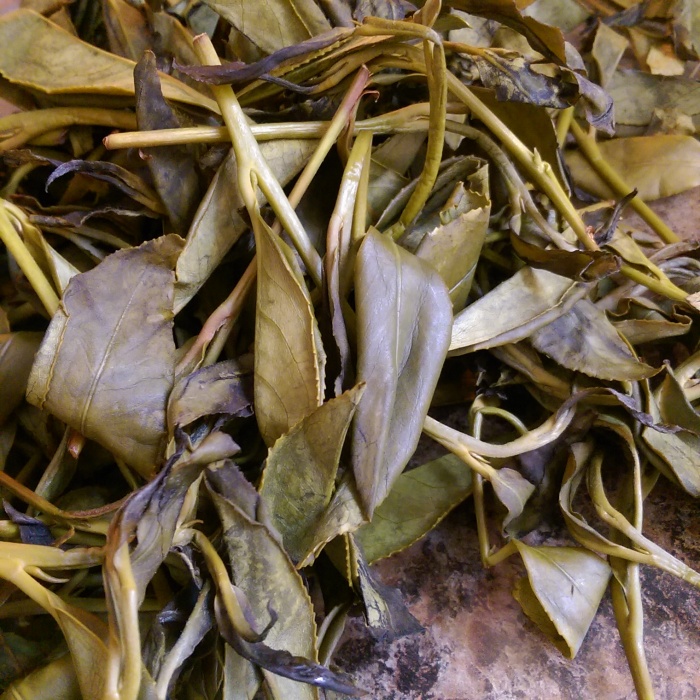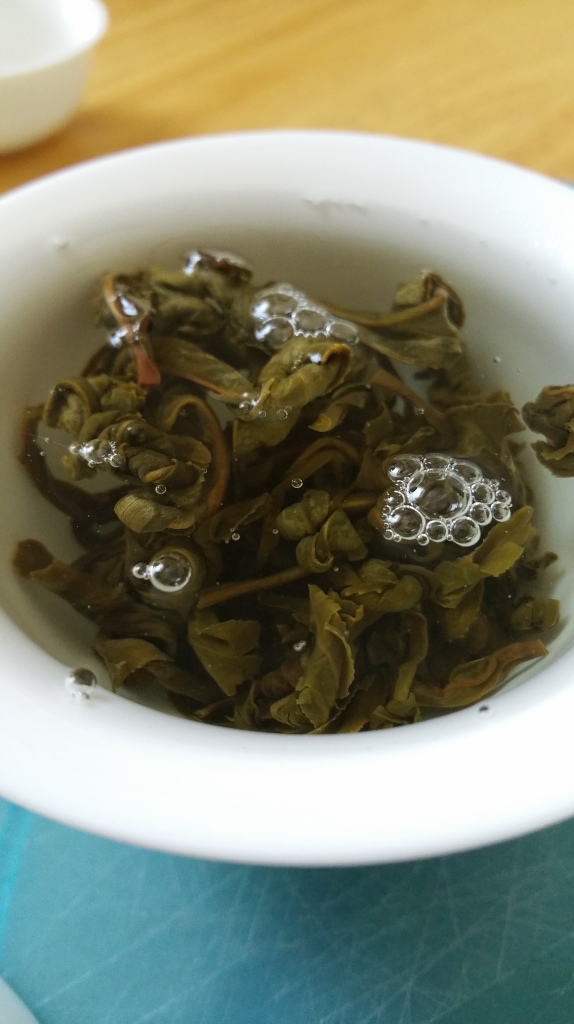My brother in tea, Dennis, gifted me an order of fresh, raw tea leaves from Boston Teawrights for Christmas. Serendipitously, they arrived in the mail while he was at my house for a visit and we got to work immediately! Boston Teawrights is a unique business that provides tea lovers with the opportunity to craft their own teas using fresh tea leaves, sourced from seasonal growing regions throughout the year. I admit that I was skeptical at first that I could make a tea in my kitchen. I have such reverence for the teas that I have been drinking for the past few years that I thought they required arcane secrets to craft that someone like me, who didn’t grown up in a tea making family, could never understand. As you will see, I was pleasantly surprised with the outcome of our first foray into tea crafting.
We decided to make a green tea. We wilted the leaves in a pan on the stove top, as opposed to steaming them, during what is commonly referred to as the kill-green process. Simply put, this is bringing the tea leaves up to a certain temperature which will prevent any chance of the leaves oxidizing. Steaming green teas is common in Japan; pan-frying is common in China. This is a generalization of course. Now, when I say pan-frying, we weren’t sauteing the leaves in oil like preparing greens for dinner. We were turning the leaves over on a moderate heat in a dry pan so that the heat would wilt the leaves to a soft and leathery state, almost like a chamois cloth. Because we were using all of the leaves in the bud set together in the pan, it took longer for the larger leaves to accept the heat and become soft and pliable, and so the smaller buds were wilted sooner and more thoroughly, turning them a darker shade of olive green. This gave me some insight as to how sorting the leaves could have made for a more controlled process, but I wanted to include all of the leaves in one big batch to make a more rustic tea that showed us all that these trees had to offer.
 Once all the leaves were wilted, we plucked all of the leaves from the stems and separated them into two piles, saving the stems for a twig tea. Then came the twisting. This was the most laborious part and gave me much more of an appreciation for any tea that is hand crafted as opposed to machine rolled or pressed. It took a long time, but it was really nice to sit with Dennis and have nothing to do but twist little tea leaves into pig tail corkscrews for an hour or so. The leaves had dried out a bit from the heat of the pan, and so I added a little mist of water to our piles so that we wouldn’t crack and break the leaves as we worked them. This may have been the part of the process that was most responsible for the outcome of our tea. With a bit of extra moisture on the leaves as we worked them, they were covered in sticky sap that stuck our fingers together and sat on the twisted leaves like a glaze. I’m just a fledgling teacrafter, but I believe that being able to draw out so much liquid from the leaves and keep it on the leaves like this, made for some incredible steeps.
Once all the leaves were wilted, we plucked all of the leaves from the stems and separated them into two piles, saving the stems for a twig tea. Then came the twisting. This was the most laborious part and gave me much more of an appreciation for any tea that is hand crafted as opposed to machine rolled or pressed. It took a long time, but it was really nice to sit with Dennis and have nothing to do but twist little tea leaves into pig tail corkscrews for an hour or so. The leaves had dried out a bit from the heat of the pan, and so I added a little mist of water to our piles so that we wouldn’t crack and break the leaves as we worked them. This may have been the part of the process that was most responsible for the outcome of our tea. With a bit of extra moisture on the leaves as we worked them, they were covered in sticky sap that stuck our fingers together and sat on the twisted leaves like a glaze. I’m just a fledgling teacrafter, but I believe that being able to draw out so much liquid from the leaves and keep it on the leaves like this, made for some incredible steeps.
After the leaves were thoroughly twisted and rolled, and the stems were given their own love, we baked the tea for about 2.5 hours at 225 degrees on a baking sheet. They were probably completely dry after an hour, but I wanted to make sure that there was no moisture left in them so that they would store better. I wanted to make sure I could keep this tea safe for special occasions in the future.
We let the tea cool for about 20 minutes and heated up some spring water. I was really excited to try this labor of love. We washed the tea, and like always, I wanted to taste the wash to see what was coming out of the leaves when hot water first hit them. The taste was familiar but utterly unique in green teas. From the wash and throughout the steeps we were hit with a beautiful and hearty toasted pumpkin seed flavor that happens to be my favorite flavor and aroma in teas. When I first started to drink good tea, I fell in love with a Baihao Yinzhen, White Hair Silver Needle, or Downy White, that displayed subtle notes of this toasted pumpkin seed. It brought back memories of being younger around Halloween and taking the seeds from carving jack o’lanterns and baking them on a cookie sheet with some salt. Some other people call this note roasted squash, and I think that in different teas, specifically greens, I have picked up on a bunch of different squashy notes from butternut to yellow summer squash.
Steeping this tea was a joy. We were able to pull close to 10 steeps out of it before we had to put it to rest, but we could have kept going if we let the tea steep indefinitely. It took a while for the leaves to untwist but that only kept enough flavor sealed away for the next steep. And as the leaves untwisted little by little, more of that sap was released into the hot water and the tea remained full flavored throughout the session. We got tea drunk after the wash, right at the first steep. It may have had to do with how much of that essence was twisted and squeezed out of these leaves, but this tea hit us with all that it had to offer. I found myself staring over Dennis’ shoulder out at the snow for a good long while as the tea worked itself through my mind. He said, “I think I’m tea drunk.” And I said “Yep. I just found myself staring off to some far away place out the window.” We laughed and for the rest of the session were both very cheerful drinking this tea that we made.
I entered this process not knowing what to expect, and doubting that I could make a tea that rivaled the classics that I had been drinking from Yuanshan, Longjing, and other well established, well crafted Chinese teas. I’m not about to say that we are suddenly tea masters, but what we drank that day was just as good as any other green I have ever drank and much better than most. I said during the session that it may have been the best green I have ever had. It certainly is one of the best. This is a personal opinion, because as I explained I am pretty fond of the specific flavors and aromas that this tea offered to us, but aside from that all, it was damn good tea. Will I do it again? I already have two more batches of leaves coming my way from Caleb’s next shipment, and I am scheming about what types of teas I am going to make.
I recommend this experience to anyone who has a passion for tea, specifically Chinese or Japanese teas, as these leaves aren’t going to bare much resemblance to an Indian Assam or Darjeeling. Crafting the tea gives you an appreciation for how any variation in the process can affect the outcome of the finished tea. You get the chance to see with your own eyes what the leaves experience as you work them, how it feels to shape a leaf into the forms we are familiar with, and how the larger leaves differ so greatly from the tender buds as far as tea crafting goes. An order of 100g of fresh leaves costs $17.75 with shipping. When you finish crafting the tea, it yields about 30g or 1oz. If you compare this to other teas, it is like buying a very high quality high mountain Taiwanese oolong from a boutique source such as White2Tea or TeaUrchin, or splurging on a good raw Puer. But I find that you shouldn’t think of ordering these fresh tea leaves just to have tea in the cabinet. You should acquire some of these leaves for the chance to experience the other side of your tea passion.
Thanks for reading. I hope that you all give this a shot. I was really pleasantly surprised with the results and found it to be a one of a kind experience that I will cherish and continue to pursue. It added to my understanding of tea greatly.












